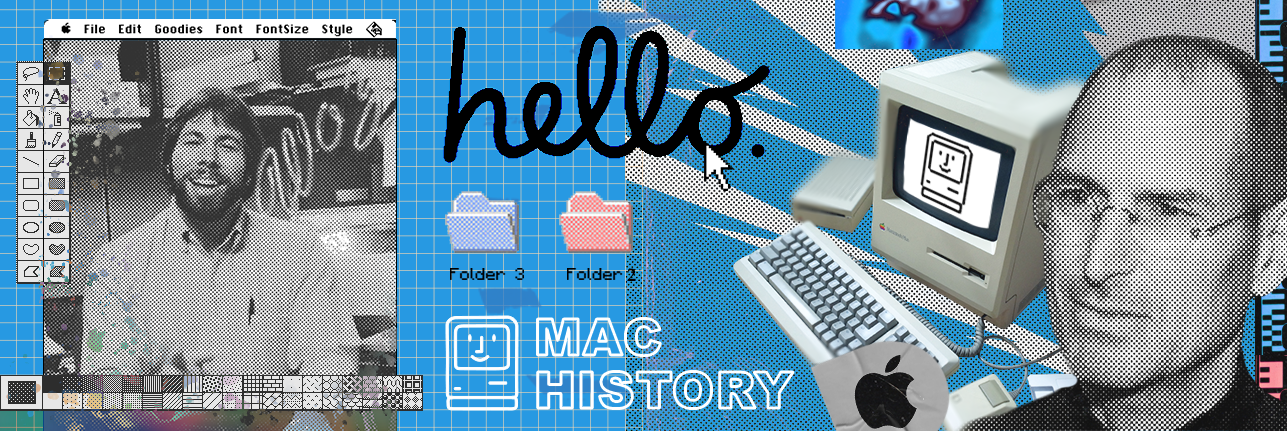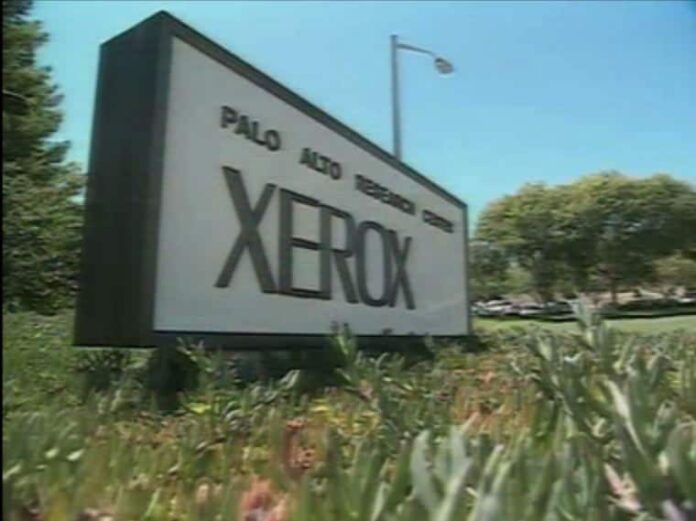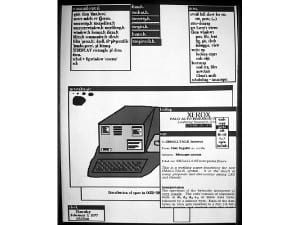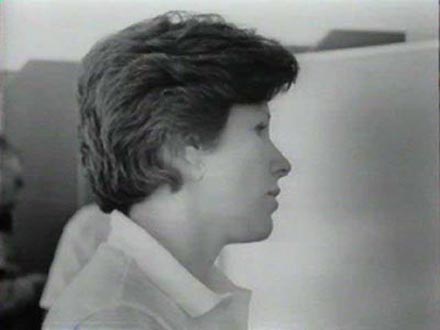There were actually two visits by groups from Apple to Xerox PARC in 1979. Steve Jobs was on the second of the two. Raskin, who helped arranged both visits, explained that he wanted Jobs to visit PARC to understand work that was already going on at Apple. The Macintosh project had escaped the chopping block several times, and Raskin had tried to explain to Jobs the significance of the technologies it was incorporating. By showing that other companies considered this kind of work exciting, Raskin hoped to boost the value of the Macintosh’s work in Jobs’ eyes.
Raskin, who had been charged initially with the Macintosh project at Apple, tried to convince the Apple management to employ a graphical user interface like the Alto contained in the development of the Lisa. According to Raskin, it was not until Bill Atkinson supported him that Jobs set out for the PARC.
Whatever way the contact was actually accomplished, this visit meant a turning point to the life of Steve Jobs; the three technologies that the 24-year-old encountered there were each revolutionary on their own: the first graphical user interface for computers; networked Alto computers; and object-oriented programming.
In 1995 Steve Jobs could still remember it exactly. In an interview with Robert X. Cringely for the PBS show “Triumph of the nerds” he said:
I had three or four people (at Apple) who kept bugging that I get my rear over to Xerox PARC and see what they are doing. And, so I finally did. I went over there. And they were very kind. They showed me what they are working on. And they showed me really three things. But I was so blinded by the first one that I didn’t even really see the other two. One of the things they showed me was object oriented programming – they showed me that but I didn’t even see that. The other one they showed me was a networked computer system… they had over a hundred Alto computers all networked using email etc., etc., I didn’t even see that. I was so blinded by the first thing they showed me, which was the graphical user interface. I thought it was the best thing I’d ever seen in my life. Now remember it was very flawed. What we saw was incomplete, they’d done a bunch of things wrong. But we didn’t know that at the time but still thought they had the germ of the idea was there and they’d done it very well. And within – you know – ten minutes it was obvious to me that all computers would work like this some day. It was obvious. You could argue about how many years it would take. You could argue about who the winners and losers might be. You could’t argue about the inevitability, it was so obvious
Steve Jobs about his visit to Xerox PARC – Clip from Robert Cringley’s TV documentation “Triumph of the Nerds“.
Jobs decided to realign Apple’s strategy and fully rely on the “graphical user interface” (GUI) he had seen at the Xerox PARC.
Adele Goldberg, who had been a researcher at the PARC at that time, already suspected that Jobs’ visit would entail extensive consequences: “He came back, and I almost said ‘asked’ but the truth is ‘demanded,’ that his entire programming team get a demo of the Smalltalk System, and the then head of the science center asked me to give the demo because Steve specifically asked for me to give the demo, and I said ‘no way.’ I had a big argument with these Xerox executives, telling them that they were about to give away the kitchen sink, and I said that I would only do it if I were ordered to do it, cause then, of course, it would be their responsibility, and that’s what they did.”
Steve Jobs hab no idea that Adele Goldberg had tried to convince her bosses not to do the presentation in beforehand. She argued against doing it for three hours.
He (Steve Jobs) came back and I almost said asked, but the truth is, demanded that his entire programming team get a demo of the Smalltalk System and the then head of the science centre asked me to give the demo because Steve specifically asked for me to give the demo and I said no way. I had a big argument with these Xerox executives telling them that they were about to give away the kitchen sink and I said that I would only do it if I were ordered to do it cause then of course it would be their responsibility, and that’s what they did.
Adele Goldberg, Founder, PARC Place Systems
Steve Jobs had his own reasons for visiting PARC. Apple bought access to the PARC by means of a stock deal that seemed lucrative to the Xerox managers on the East Coast: They might buy 100,000 Apple stocks for one million dollars. Holding this admission ticket in the hand, Steve Jobs, Apple’s president Mike Scott, Bill Atkinson, and a number of members of the developing team marched up. “I think mostly … what we got in that hour and a half was inspiration and just sort of basically a bolstering of our convictions that a more graphical way to do things would make this business computer more accessible.”

Larry Tesler, who then took part in the demo as an employee of the PARC, had been fascinated by the visitors: “After an hour looking at demos, they understood our technology and what it meant, more than any Xerox executive understood after years of showing it to them,” Tesler told Robert X. Cringley in the PBS-Show “Triumph of the Nerds” (1996).
In late 2011 after Steve Jobs death Tesler recalled Steve Jobs’ visit at an event at the Churchill Club:
Steve Jobs’ visit of the Xerox Palo Alto Research Center in 1979 became in 1999 a topic in the movie “Pirates of Silicon Valley”. The narrator in this scene (role of Steve Wozniak”) says more or less, that the Apple guys got a “miracle bag” from Xerox: the idea of the WYSIWYG, the mouse-driven graphical user interface – “like rich people giving junky old stuff to the Salvation Army, only the junk turns out to be a Rembrandt.”
But to be fair: The movie does not tell the whole story: Yes, the Macintosh team got an important demo (PARC was compensated with a pre-IPO Apple stock deal). They took up the ideas of the Xerox PARC, but it also changed numerous operating modes and added countless new features. Accordingly, the Xerox Alto did not imply, for example, menus flapping down from the upper edge of the screen, but operated with some kind of a pop-up window instead. Moreover, the window did not open automatically by double-clicking on a document, but had to be opened manually. During months of painstaking work, Atkinson had written the QuickDraw routine for the Lisa and the Macintosh, which allowed for overlapping windows to be drawn on the computer screen for the first time.
Read next page: Macintosh-Developer Andy Hertzfeld about Xerox PARC
Macintosh-Developer Andy Hertzfeld said in an Interview with CNET:





Nice Information on Xerox Printers
Thanks Xerox, you’re the one !
[…] network, data moves explicitly,” Lunt said. “With CCN, the data just moves.” Read more . . . [caption id="" align="alignright" width="300" caption="Image via Wikipedia"][/caption] Updated. Xer…NetworkTopology-Mesh.png" alt="Image showing mesh network layout" width="300" height="227" […]
[…] в дебри истории, «критики» вспоминают, что Xerox Alto (первый ПК с графическим интерфейсом) появился […]
Myth: Xerox management were stupid/did not attempt to commercialize the technology
Fact: The Xerox Star was sold to the public years before the first Apple system with such a user interface: the Lisa.
Myth: Xerox management were stupid not to prosecute Apple earlier
Fact: Xerox was under anti-trust supervision at the time much like AT&T and IBM. It would be very dangerous from them to be seen squashing a competitor. Software patents were generally unenforceable. Apple claimed Xerox only had the ideas and ideas we not copyrightable only the expression of the ideas.
Myth: THe Xerox Star was sold to the public years before the first Apple system with such a user interface: the Lisa.
Fact: the Xerox Star was sold in the second half of 1981. The first Lisa was produced 1982. So it’s month, not years.
[…] Consiglio questo link per un racconto completo dell’incontro tra ingegneri ed executive di Apple (tra cui Steve Jobs) e vari personaggi allo Xerox Parc. […]
Myth: Peter is right
Fact: Peter has no life
[…] https://www.mac-history.net/computer-history/2012-03-22/apple-and-xerox-parc/ […]
Two lines devoted to the 1988 court case. Didn’t wanna quote what the JUDGE said about Apple’s theft of Xerox’s intellectual property, eh? And emphasizing that not a single line of code was stolen? COME ON. The issue is Raskin knowing about Xerox’s work and dragging Jobs along to ensure the (stolen) GUI idea got funded at Apple. This was never about stolen code and the use of “everything” in the title is a silly way to give deniability to one of the greatest thefts of intellectual property in history.
Zimborg said:
Myth: Xerox management were stupid not to prosecute Apple earlier
It’s sad that such implied anti-Apple bias and hatred still exists despite the facts as laid down right before us by the people that were on the scene.
Apple PAID upfront for use of the GUI technology with a very large amount of shares from their IPO, and furthermore vastly improved the technology along the way.
Meanwhile, Xerox’s own workstation offerings at the time are reported to have cost about $16,000 a pop, and would not work without a Server that cost $24,000!!!
And these rabid haters still consider Apple products expensive.
[…] Media Library – PARC, a Xerox companny […]
[…] came on the shoulders of others. The original Mac UI and mouse paradigm having started at Xerox Parc and such… but that is not really relevant. There is no denying that Jobs’ had the ability […]
All .com neuvo riche transplants who screwed palo alto into shallow alto….thanks a##&oles!
[…] https://www.mac-history.net/computer-history/2012-03-22/apple-and-xerox-parc/2 […]
[…] http://www.livescience.com/37944-how-the-human-computer-interface-works-infographics.html https://www.mac-history.net/computer-history/2012-03-22/apple-and-xerox-parc http://www.technologyreview.com/news/534206/a-brain-computer-interface-that-works-wirelessly/ […]
What was told to me, in vague terms, was that Alan Kay was on the team that invented SmallTalk and that Apple hired him because Xerox failed with the Alto and Star systems and that they weren’t interested in going after the lower price home/smaller personal computer market, which is partly why not only Alan Kay left PARC, but Metcalfe ended up leaving to start up 3Com, so since they developed the technology and Xerox didn’t have any plans to do anything with it, they left to go elsewhere to further develop the GUI.
By the time the first GUI came out with Apple, Xerox had nothing on the market because they had already canned the Alto and Star projects, plus they were VERY expensive and the average person couldn’t afford them. Obviously Apple made some improvements and changes to make it more useful. And obviously it stuck and the GUI has just gone through improvements.
Why don’t people say that 3Com stole ethernet from PARC too? Same thing. Metcalfe engineered Ethernet while he was at PARC and he left PARC to start up 3Com. It’s almost the same thing because Alan Kay worked on the early Alto/Star SmallTalk and GUI with PARC and he left to go to Apple to help develop the Mac.
On your youtube you had Xerox PARC Demo for Apple and now it is private. I need it for my NHD project, so I was wondering if you could un-private it or send me an email with the video file in it. My email is yodacrafter2000@gmail.com
sincerely,
David McHugh
[…] is also where Steve Jobs and early Apple engineers took inspiration for aspects of the Macintosh […]
[…] is also where Steve Jobs and early Apple engineers took inspiration for aspects of the Macintosh […]
[…] is also where Steve Jobs and early Apple engineers took inspiration for aspects of the Macintosh […]
[…] [16] https://www.mac-history.net/computer-history/2012-03-22/apple-and-xerox-parc/2 […]
[…] [16] https://www.mac-history.net/computer-history/2012-03-22/apple-and-xerox-parc/2 […]
[…] inventions, but was also a huge influence on the whole computer industry. PARC was arguably the largest influence on Steve Jobs, and shaped the philosophy with which he would run Apple. They themselves are a shining example of […]
[…] https://www.mac-history.net/computer-history/2012-03-22/apple-and-xerox-parc […]
[…] https://www.mac-history.net/computer-history/2012-03-22/apple-and-xerox-parc […]
[…] was introduced in 1981. Although the description, personal Computer, was used in 1972 to indicate Xerox PARC’s Alto, the term PC was largely associated with IBM […]
[…] Apple did not steal the GUI from Xerox, they had given Xerox shares of Apple to see their work. There was no working relationship between Apple and Xerox. No lines of code were stolen. Xerox’s attempt to sue Apple was dismissed by the courts. Apple’s Lisa team was already developing a GUI at the time Apple employees visited Xerox. […]
The concept that apple could use it because Xerox was not using it is ridiculous. So if a movie company is not selling a movie anymore, do you have the right to steal it? Or if someone comes in my home and steals something that I am not using it is okay? The idea that Apple is an honest company is ludicrous. I go into details without getting myself in trouble, but I have a lot of inside information on how they destroyed companies, had their buddies at the FBI railroad people to jail for doing something that could hurt their bottom line, etc. Everyone knows that the hide their money in Scotland so they only pay 1% tax. But to be honest that is they way all big business is, and if anyone thinks they got rich being fair and honest, they are a fool
[…] uno de los primeros ordenadores personales de la historia y Steve Jobs y los ingenieros de Apple se inspiraron en algunas de sus novedades y conceptos, como el uso de una interfaz gráfica, para sus propios […]
[…] de los primeros computadores personales de la historia y Steve Jobs y los especialistas de Apple® se inspiraron en varias de sus noticias y conceptos, como el uso de una interfaz gráfica, para sus propios […]
[…] de los primeros computadores personales de la historia y Steve Jobs y los ingenieros de Apple℗ se inspiraron en algunas de sus noticias y conceptos, como el uso de una interfaz gráfica, para sus propios […]
[…] uno de los primeros computadores personales de la aventura y Steve Jobs y los analistas de ©Apple se inspiraron en varias de sus noticias y conceptos, según el uso de una interfaz gráfica, para sus propios […]
[…] uno de los primeros ordenadores personales de la historia y Steve Jobs y los ingenieros de Apple se inspiraron en algunas de sus novedades y conceptos, como el uso de una interfaz gráfica, para sus […]
[…] uno de los primeros ordenadores personales de la historia y Steve Jobs y los ingenieros de Apple se inspiraron en algunas de sus novedades y conceptos, como el uso de una interfaz gráfica, para sus propios […]
[…] uno de los primeros ordenadores personales de la historia y Steve Jobs y los ingenieros de Apple se inspiraron en algunas de sus novedades y conceptos, como el uso de una interfaz gráfica, para sus propios […]
[…] uno de los primeros ordenadores personales de la historia y Steve Jobs y los ingenieros de Apple se inspiraron en algunas de sus novedades y conceptos, como el uso de una interfaz gráfica, para sus propios […]
[…] uno de los primeros ordenadores personales de la historia y Steve Jobs y los ingenieros de Apple se inspiraron en algunas de sus novedades y conceptos, como el uso de una interfaz gráfica, para sus propios […]
[…] uno de los primeros ordenadores personales de la historia y Steve Jobs y los ingenieros de Apple se inspiraron en algunas de sus novedades y conceptos, como el uso de una interfaz gráfica, para sus propios […]
[…] uno de los primeros ordenadores personales de la historia y Steve Jobs y los ingenieros de Apple se inspiraron en algunas de sus novedades y conceptos, como el uso de una interfaz gráfica, para sus propios […]
[…] uno de los primeros ordenadores personales de la historia y Steve Jobs y los ingenieros de Apple se inspiraron en algunas de sus novedades y conceptos, como el uso de una interfaz gráfica, para sus propios […]
[…] uno de los primeros ordenadores personales de la historia y Steve Jobs y los ingenieros de Apple se inspiraron en algunas de sus novedades y conceptos, como el uso de una interfaz gráfica, para sus propios […]
[…] uno de los primeros ordenadores personales de la historia y Steve Jobs y los ingenieros de Apple se inspiraron en algunas de sus novedades y conceptos, como el uso de una interfaz gráfica, para sus propios […]
[…] uno de los primeros ordenadores personales de la historia y Steve Jobs y los ingenieros de Apple se inspiraron en algunas de sus novedades y conceptos, como el uso de una interfaz gráfica, para sus propios […]
[…] between when the legend of Xerox PARC and Apple and later, Apple and Microsoft growling over who stole what from whom, it started changing. It […]
[…] making a prototype, but the ability to put across a concept in a compelling manner. The ill-fated Xerox PARC, the one lab responsible for some of computer science’s biggest ‘inventions’, is a case in […]
[…] making a prototype, but the ability to put across a concept in a compelling manner. The ill-fated Xerox PARC, the one lab responsible for some of computer science’s biggest ‘inventions’, is a case in […]
[…] https://www.mac-history.net/computer-history/2012-03-22/apple-and-xerox-parc (Steve jobs was a theif?) […]
[…] Did Steve Jobs steal everything from Xerox PARC? […]
[…] Did Steve Jobs steal everything from Xerox PARC? […]
[…] R&D complex in exchange for a chunk of Apple shares. Did Apple steal ideas from Xerox? Debate rages online to this day, but if he did, inviting in Apple was one costly mistake for […]
[…] Mac History: https://www.mac-history.net/compu… […]
[…] the Xerox Star that he had seen, but it was more than that and different. He did not merely copy; he stole from a flailing research project to create a computer that defined the modern interface. Dylan, like Jobs, stole from his Western […]
[…] Mac History: Did Steve Jobs steal everything from Xerox PARC? […]
[…] Mac History: Did Steve Jobs steal everything from Xerox PARC? […]
[…] Xerox ideas of a GUI (Graphical User Interface) from its Xerox Alto computer. Although the whole story is debatable, it is a fact that the Xerox Alto was the precursor of the user interface we still use today, […]
Tour or trade show? He and Apple didn’t steal anything it was part of an investment agreement that xerox greatly benefited from. I don’t understand how even Walter Issacson can also claim Steve “stole” the technology shortly after mentioning how he acquired it in the first place. People love to point the finger.
[…] [1] https://www.mac-history.net/computer-history/2012-03-22/apple… […]
[…] ^ “Did Steve Jobs steal everything from Xerox PARC?”. […]
In every visit Xerox gave a copy of the OS to anyone who wont it, so nither Jobs or Gates stoled anything, only made reverse engennering an made pirate OS, that in fact windows and mac os are.
[…] ^ “Did Steve Jobs steal everything from Xerox PARC?”. […]
[…] utilisés aujourd’hui, et notamment la tablette (il l’appelle Pad dans l’article…). Même s’il y a controverse à ce sujet, le PARC a contribué de façon puissante et concomitante à l’éclosion de nombreuses inventions […]
[…] Picasso. Apple certainly allegedly copied several ideas to incorporate into their products (see Xerox). At the same time, Jobs had publicly accused Microsoft from ripping off the Mac. However the […]
[…] Mac History: https://www.mac-history.net/computer-history/2012-03-22/apple-and-xerox-parc […]